Saving Sturgeon
Sturgeon may be one of the most enigmatic and endangered of fish, but Erin Stoddard aims to change that.
Article body copy
Sturgeon are one of the more imperiled fish species in the world. Beloved of anglers, caviar fans, and Indigenous groups who have had a long relationship with this big prehistoric-looking fish, sturgeon have a confounding life history. We don’t know a lot about them, whether they’re swimming in Russian or Canadian waters. Writer Laura Trethewey gives readers a glimpse into the life of this enigmatic species in her new book The Imperiled Ocean: Human Stories from a Changing Sea, and that glimpse is lovely.
The book ranges across ocean issues. Trethewey shares a depth and breadth of ocean stories, from refugees risking their lives to flee horrific circumstances to the cruelty experienced by cruise ship laborers to the labor of filming underwater scenes. Alternating between grim and hopeful, the author ultimately believes we can all create a healthier ocean, whether we work with fish, refugees, or bring the magic of the seas to screens big and small.
One afternoon not long ago, I looked a fish in the eye and saw something beautiful. Her small pupils revealed a deepening maze of tawny, glistening yellows. Her scales at first looked gray and matte, but when I moved in closer—and I mean nose-to-scale close—her armored skin became a kaleidoscopic swirl of colors and shapes: purple diamonds, coral glints, blots of black like spilled ink. On each side of her half-moon gills was a starburst of metallic purples and pinks, like she was wearing the most awesome earrings in the world.
Then, with a quick flash of her tail, the sturgeon and her hallucinogenic-colored skin and eyes were gone, released back into the water. Every second she spent with me out of the estuary jeopardized her return to the water. Here in British Columbia’s Fraser River, she and thousands of other white sturgeon like her swim in and out of the Pacific Ocean. It’s where biologist Erin Stoddard, a stocky 53-year-old fisheries biologist, studied this mysterious fish for 15 years.
Most would not call the sturgeon beautiful. It certainly doesn’t have the aesthetic appeal of a frolicking dolphin or the cuddliness of a big-eyed seal. Instead, it has the plated skin of an alligator, and the upright back tail and white belly of a shark. Sturgeon are widely distributed across the northern hemisphere, from rivers in China and Russia to the Great Lakes and the Sacramento River. One of the largest sturgeon ever reeled in on the Fraser River in recent years stretched over 3.5 meters, rivaling the length of the boats that caught it, and weighing more than a grand piano. A sturgeon trawls the river bottom, its catfish-like whiskers dragging through the mud, its pointed chin pockmarked with papillar taste buds. It looks like a relic from a fiercer time, perhaps as early as the Carboniferous period according to new research, and the sturgeon’s anatomy has changed remarkably little since it evolved in prehistoric oceans and rivers. To fish nerds, this is a cool fish.
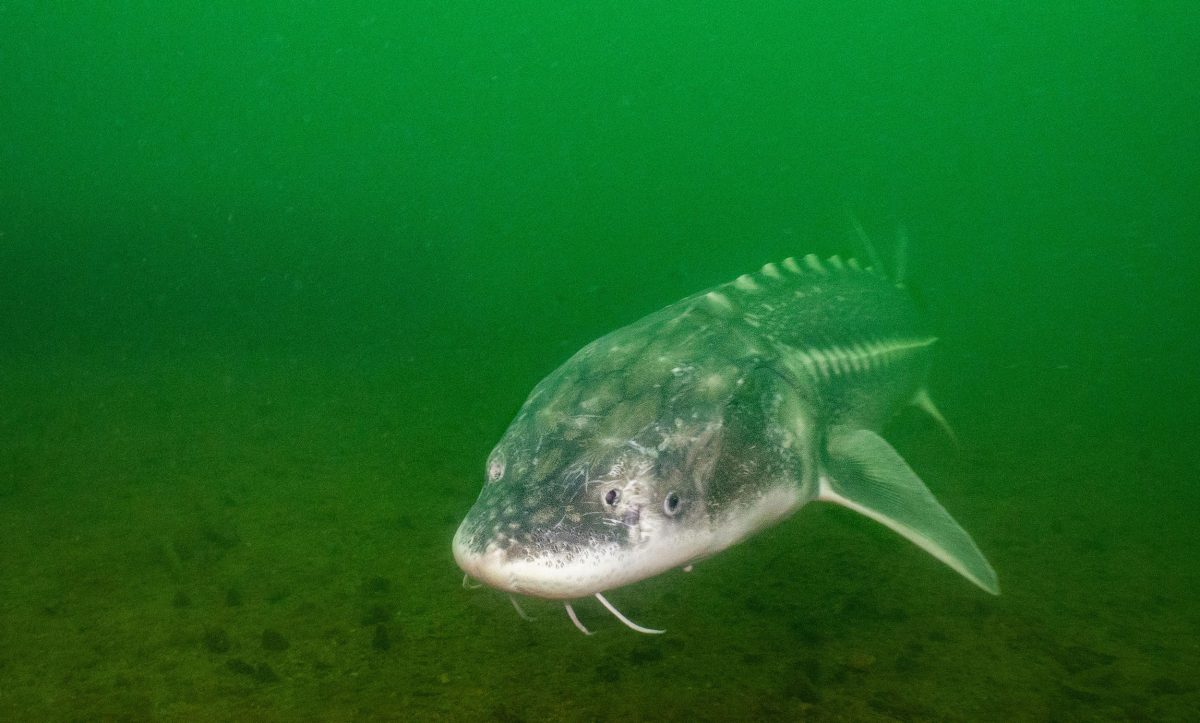
Sturgeon have four catlike whiskers located between their pointed snout and their mouth, which help them find food in the murky bottoms. Photo by Fernando Lessa/Alamy Stock Photo
Nearly every population of sturgeon around the world is in some sort of trouble. In the mega-dammed, overdeveloped Yangtze River, the wild Chinese sturgeon will likely go extinct before 2030. The once-abundant Alabama sturgeon is now so rare it’s gained an almost mythic status in that state. In the Caspian Sea, people have poached and overfished the massive beluga sturgeon to near extinction. In the lower Fraser River, where Stoddard worked, this fish swims through the most dammed, diked, and developed land in the Pacific Northwest. New ports, new bridges, new dikes, new levies, and new drainage projects are always in the works right in the sturgeon’s habitat. The International Union for Conservation of Nature has estimated that the sturgeon group of species is more endangered than any other in the world. Aquaculture may be the only future left for sturgeon: already 90 percent of young beluga sturgeon come from artificial breeding.
At first glance, the white sturgeon population in the lower Fraser River seems healthy. In 2015, around 45,000 sturgeon swam and spawned and fed in the river and out in the Pacific Ocean. But this number actually hides a worrying reality: sturgeon can live over a hundred years, and many of those fish are on the older side.
“That’s part of the difficulty of being a sturgeon biologist,” said Stoddard. He was directly responsible for the future of white sturgeon in these parts. “Their generations are similar to ours. How can you tell when you’ve come to a recovery state, or when it’s time to do other management, if it takes 30 years to figure that out?”
Along the Fraser River, each new condo development and overpass takes another bite out of the naturally loose gravel along the riverbanks, where sturgeon hide their eggs. Studies show that the next generation is struggling to reach sexual maturity: since 2004, juvenile numbers have declined as much as 50 percent. Nearby populations in the Columbia, Kootenay, and Nechako Rivers are in worse condition. For years now, they haven’t had a significant spawn that would boost their numbers. This is particularly worrying in a late-blooming fish like the sturgeon. Males start spawning around 15 years old, while females can take 18 years to produce eggs. By the time the next generation arrives, the population may have already suffered a catastrophic, ecosystem-destabilizing decline.
It was a good day to be Stoddard. Normally, he spent his days inside a drab government building in a suburb of Vancouver, managing and studying the fish populations of the lower Fraser River from his computer. In terms of sturgeon, that might mean reprimanding fishing guides for incorrectly handling the fish, or helping his team crack down on restaurants with poached sturgeon swimming in their tanks, and even closing the recreational fishery down altogether, which he considered doing for the first time in 2015 when the river temperatures rose to unprecedented levels and the water level dropped drastically. But this foggy morning, he was loading up his research boat for one of those rare days in the field, catching sturgeon and tagging them with acoustic trackers. It was year three of Stoddard’s 10-year study tracking and gathering basic information about white sturgeon. A dozen boats sat nearby on the gravel shore, waiting for the annual sturgeon-fishing derby to begin.
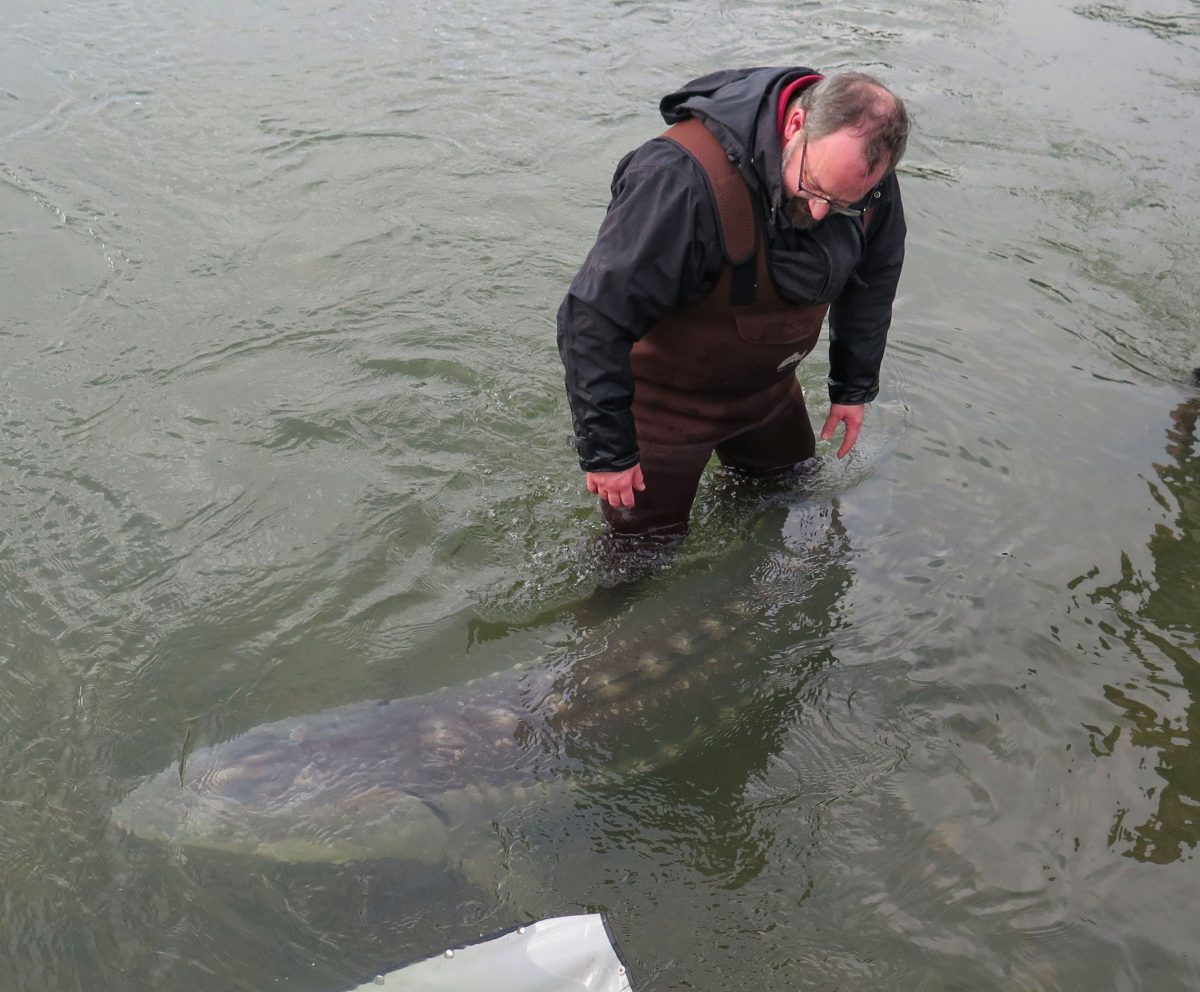
Now retired, fisheries biologist Erin Stoddard spent 15 years studying white sturgeon. He initiated a 10-year study on adult sturgeon to track their movements through British Columbia’s Fraser River and learn about their life history traits. Photo courtesy of Erin Stoddard
Here are some things we know and don’t know about sturgeon. Sturgeon are not just freshwater fishes. They spawn in rivers, but they roam out to sea regularly. Like salmon or eelfish, they move between inland water and tidal water—a piscine scorecard for how humans are treating both habitats. We know sturgeon swim out to the ocean, but we don’t know where they go or what they do out there. In 2009, sturgeon flummoxed researchers when 1,500 fish stranded themselves on the banks of Washington State’s Puget Sound. Was this a feeding frenzy gone wrong when the tide lowered? Because scientists are still unclear on what exactly sturgeon do in the ocean, it’s hard to know.
Sturgeon like to jump, but we don’t know why. This may sound like normal fish behavior, but a sturgeon jump is like a rocket liftoff compared to the ripple-like effects of other jumping fish. They shoot to the surface with such force and speed that they launch themselves out and over the water, twisting and turning and smacking down on the surface—sometimes with terrible results. A sturgeon once leapt into a boat in Florida and killed a five-year-old girl. White sturgeon get jumpy in February. Are they feeding? Communicating? We don’t know.
Another mystery is the massive sturgeon ball. In the winter of 2008, a sonar survey revealed a big pile of something at the bottom of the 60-meter-high Bonneville Dam in Washington State. State officials figured the dam must have been crumbling into the Columbia River. Instead they discovered a gigantic knot of 60,000 sturgeon congregating 15 meters deep. That one cluster accounted for up to 10 percent of the entire lower Columbia River population. Experts said it might have been a defensive tactic against predatory sea lions. Then again, maybe they were just feeling social.
“It would be great if even one fish went out to the ocean and came back,” Stoddard said about the more than 140 fish he was tracking in his study. That fish could give him an idea of why sturgeon go to the ocean, what time of year they leave, how much time they spend there, and what sex and size might mean for their sea mission. When the fish returned to the river to spawn, he could gather information about whether or not it went back to its usual spawning grounds. If that sturgeon’s chosen spawning site had been destroyed or altered, Stoddard could find out whether or not it adapted.
The sturgeon derby would help Stoddard add more fish to his tracking study. Any sturgeon longer than 160 centimeters reeled in was a new datapoint.
Everyone I met at the derby spoke about sturgeon in awestruck tones. Along with the volunteer fishers on the other derby boats, Stoddard’s helpers for the day were a park ranger in training, a sturgeon biologist, and Greg George, Stoddard’s wiry, excitable colleague at the Ministry of Forests, Lands, Natural Resource Operations and Rural Development. Stoddard would take on his research boat pretty much anyone who didn’t mind bobbing on the water all day long. Over the days I spent with Stoddard tagging sturgeon, I was his scrub nurse, passing him scalpels and gauze during surgery; his data recorder, taking down the length and girth of tagged sturgeon; and his personal assistant. “Where’s my wallet, Laura?” he’d ask me.
All of us loaded fishing gear and coolers onto the boat, along with waders, life jackets, toolboxes, and water bottles. “Don’t drop that on the ground,” Stoddard said after I accidentally dragged an underwater microphone on the floor. He delivered the order with such a cartoonish wince that I didn’t mind the scolding and laughed.
Stoddard grew up in the interior of British Columbia, fishing from the age of four. He knows how to set the hook deep into the sturgeon’s bloated lips and to reel in aggressively, guiding the fish up toward the surface and not giving it a moment’s slack until it’s on board.
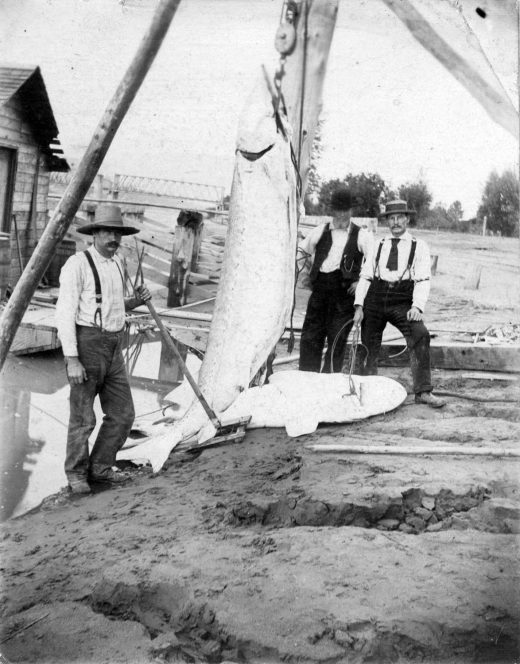
Sturgeon can live to be over 100 years old. The sturgeon pictured here on the hook was caught near Mission, British Columbia, and weighed over 360 kilograms. Photo courtesy of City of Vancouver Archives
Until the 1980s, no one tracked sturgeon here, and no one cared much about them. They were largely considered a junk fish, except by the Indigenous peoples who have lived along these coastlines and rivers for over 10,000 years. According to Stó:lō oral tradition, the sturgeon was first created when a young woman was cast into the river. The fish resurfaces in Stó:lō contemporary artwork, too, a link between past, present, and future generations.
In the 1990s, dozens of dead, bloated female sturgeon washed up mysteriously on the banks of the Fraser River. There was no clear explanation for why they died. For many people in the region, this was likely the first time they heard that a huge fish, dating back to the time of the dinosaurs, was swimming in the river behind their backyards. The provincial and federal government banned the killing of sturgeon in the lower Fraser and created a catch-and-release fishery in its place.
An apex predator like the sturgeon can have tremendous sway over the ecosystem. They eat everything from the smallest water bugs to the migrating chinook salmon. They feed the river, too, with their eggs and larvae. The sturgeon’s decline will reverberate down through the levels of the ecosystem, upsetting the already delicate balance of life. When the future of an ancient, long-lived animal is on the line, we simply don’t know all the connections we might be losing when it disappears.
At 11:00 a.m., the derby boats reversed off the beach like an armada and scattered up and down the river, staking out fishing holes. Stoddard revved up the jet engine on the research boat, while George passed out yellow earmuffs to everyone on board. The boat was a bit of a joke among the team. It was functional, but really, really loud. Out on the water, Stoddard cut the motor near a boat for a team calling itself Sturgeon Urgin’. “Hey, you got earmuffs for everyone else on the river?” the angling guide yelled over. Stoddard was about to retort when a flurry of action on the stern caught his attention. A young man in a ball cap was pulling on a rod bent in half in his shaking hands. Stoddard swiveled the boat around for a closer look as the man wrestled with something beneath the surface.
Just then a long gray flank of fish broke the surface, water splattering. The sturgeon was big, definitely an adult, and weighed over 22 kilograms: exactly the kind of fish Stoddard needed to tag for his study.
Part of the reason sport fishermen like to catch sturgeon so much is that they fight back long and hard. They’re strong swimmers and they know how to throw their weight around. Many Fraser River sturgeon are caught multiple times in their lives. Some are so well known they’re given nicknames, like Pig Nose, a legendary 300-kilogram-plus, bulbous-nosed sturgeon who was landed for the first time in 2016 and again in 2017.
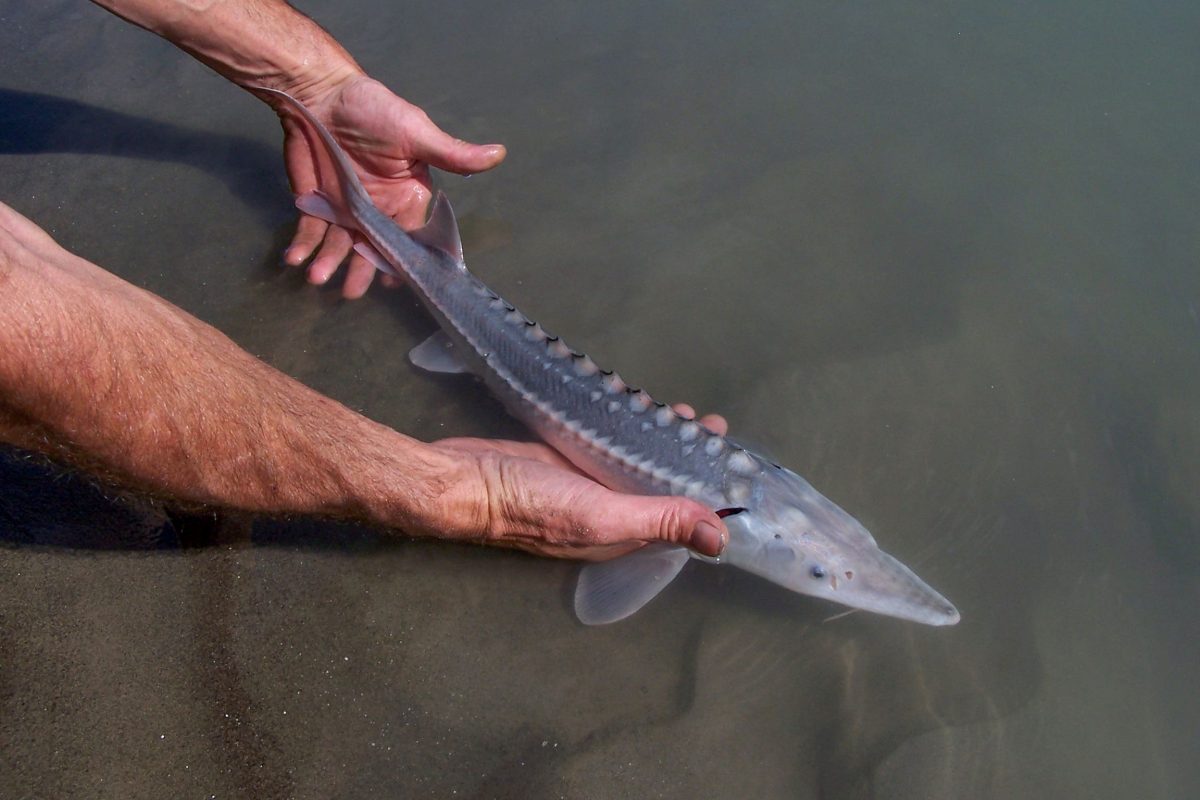
Juvenile white sturgeon numbers have declined by as much as 50 percent since 2004, making researchers worry about the future of this long-lived, slow-maturing species. Photo by R Perreault/Shutterstock
The whole catch-and-release policy is based on the premise that fish survive after they’re released to the water. But in one paper, PhD student Montana McLean and her coauthors noted that little scientific evidence exists to prove that this is true. Studies on the catch and release of shark and salmon show that stress, injury, and even death can happen after a fish is let go.
McLean and her colleagues once took sturgeon out of the water and placed them in a sling to simulate conditions a sturgeon experiences during angling. Some fish died, while others were so tired and disoriented from the experience that they could become easy prey for predators. The concern for a female sturgeon is that the fish might become so stressed during the fight that she reabsorbs the roe into her body, as fisheries expert Marvin Rosenau later told the Vancouver Sun. This could explain why, over the last decade, the number of young sturgeon in the river has declined.
Although nearby populations are already classified as endangered, the lower Fraser white sturgeon are only recommended for a threatened status by the Committee on the Status of Endangered Wildlife in Canada (COSEWIC). The only reason the white sturgeon population in the lower Fraser River is not labeled endangered, the committee noted, is their socioeconomic importance to recreational and Indigenous fishers—something the federal government does consider before listing an animal. The white sturgeon are likely in just as much trouble as the endangered populations farther north, but an endangered rating would shut down the lucrative sturgeon-fishing industry.
The Sturgeon Urgin’ fishers traded the rod back and forth, giving everyone a chance with the first catch of the day. Meanwhile, the angling guide called out directions and maneuvered the boat to the shoreline. They would have to land a fish this big on the beach. Stoddard quickly pulled waders up over his cargo pants, revved the engine again, and followed the Sturgeon Urgin’ team to shore. George and others on the research boat readied the surgical equipment, working quickly. No one wanted to delay this fish longer than necessary.
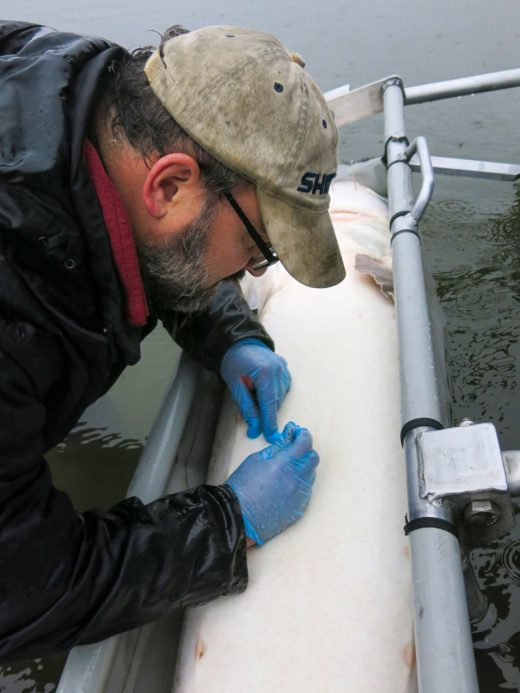
Erin Stoddard makes an incision on the underside of a white sturgeon to insert an acoustic tag into its body cavity. This tag will help researchers track the fish’s movements every time it travels past a receiver. Photo courtesy of Erin Stoddard
As the research boat hit the sandy banks, Stoddard grabbed his surgery kit and leapt into the river, water up to his waist. I followed with a clipboard and pencil. The fishers stood on the riverbank, holding the sturgeon and snapping pictures. Stoddard unrolled a yellow measuring tape along the fish’s side. “One hundred ninety-three centimeters,” he called to me, and I scrawled it down. He wrapped the tape around her girth. “Seventy-seven centimeters,” he said. The fish was about the length of a single bed. A runt compared to the giants swimming in this river.
Hoping for more fish, we motored along the water, zipping from derby boat to derby boat. Stoddard pointed out small changes he’d noticed since the last time he’d traveled this way. On starboard was an inlet where a pebbly bottom broke the surface and disrupted the current. The boat rounded a corner, and he pointed out a dike that the river had overrun.
“Have you ever heard the phrase ‘death by a thousand cuts’?” Stoddard asked. He explained that instead of a single big impact, like a dam, he saw small impacts and wondered if eventually they would rob the river of its functionality. “Rivers move like a living thing,” Stoddard explained. “When we, the people, confine them to a small space, they tend to move more and tend to move with more force. What that does is impact habitat.”
Those dams, however, can have a devastating impact on wild fish. A dam can drive up the water’s temperature and oxygen levels, while restricting the river’s flow: all essential parts of a fish habitat. Worst of all for migrating fish like sturgeon, dams make it harder for them to access their spawning sites. In fish like salmon that spawn on schedule, a dam’s impact is almost immediately apparent. If a dam stops salmon from reaching their spawning grounds in time, there will be no more salmon in the following years. With sturgeon, whose spawning patterns are not fully understood, the future is less clear. As an ancient and long-lived species, perhaps the sturgeon will figure out how to adapt. But in the Nechako and Columbia Rivers on both sides of the US-Canada border, white sturgeon are forced to conform to dams that constrict their migrations. Neither the Nechako nor the Columbia population has fared well; both are classified as endangered.
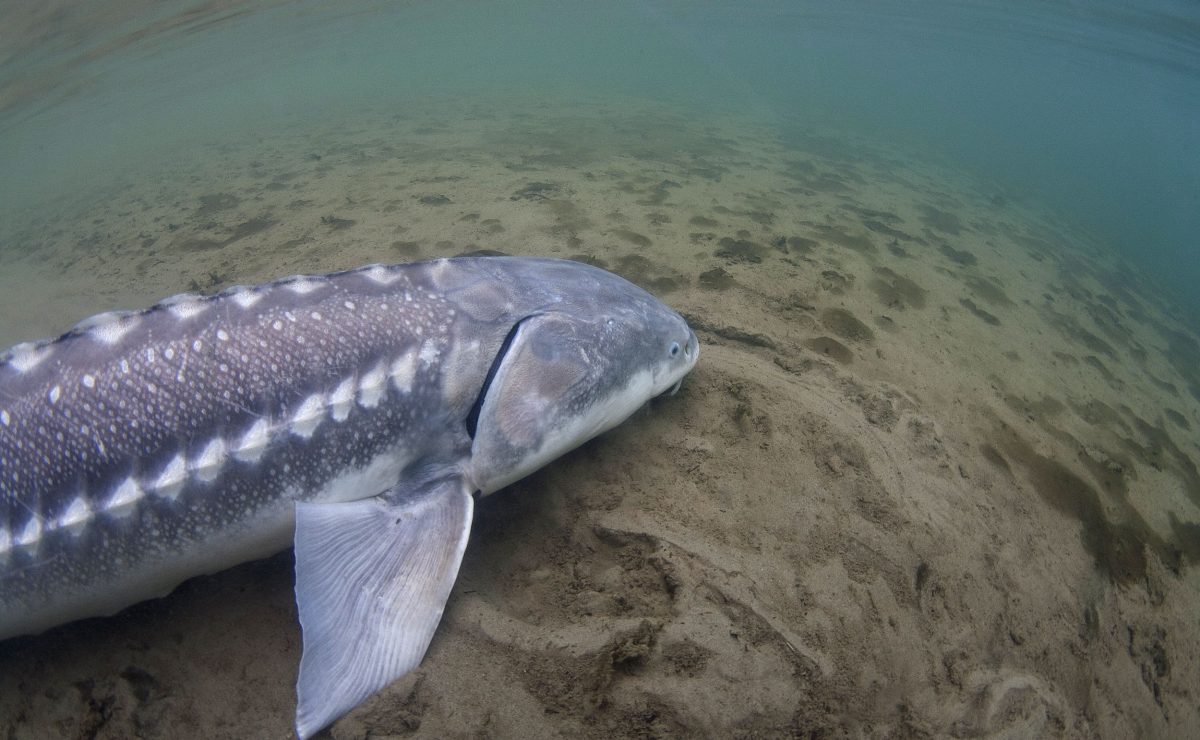
Most sturgeon populations are now in peril. According to the International Union for Conservation of Nature, sturgeon are the most endangered group of species in the world. Photo by Matthias Breiter/Minden Pictures
What’s impressive is that the main stem of the Fraser River, a massive waterway, still runs unchecked, from the mountainous slopes and evergreen forests inland, through dusty sagebrush and lush rainforest, out into a massive delta at the Pacific Ocean. The sturgeon population that Stoddard studied is one of the last in the world that still has that kind of freedom. Although the waterway is always undergoing nips and tucks from development, the fish can still migrate where they want when they need to. This is a rare opportunity to study a mystery fish’s behavior in a setting as near to natural as possible.
“Those guys aren’t catching any big fish, so we’ll catch ’em,” Stoddard said as he dusted the lunch crumbs off his waders. For the last hour, we’d waited and listened for a call from one of the nearby derby boats on the CB radio, hoping for someone to tell us they had a sturgeon on the line. Nothing, except radio silence.
It was a disappointing catch on a day that had required months of preparation. He still needed over 20 fish to round out the study. He opened up a plastic yogurt tub filled to the brim with fat electric-orange chum eggs and began to prepare sturgeon bait, washing his hands thoroughly before plunging them into the slimy tub. Sturgeon have a keen sense of smell, he explained, and any unnatural odor might put them off. Next he opened a toolbox that contained a stack of Sophisticated Miss–brand panty hose. He took a sticky glob of chum eggs, placed it on a pair of white nylons, cut a small circle around the roe, tied it with a topknot, and plunged a sizable J-hook through the little bundle.
At the stern of the boat stood a row of holsters on poles. Erin slotted a fishing rod into one holster and lowered the bait into the water. A few minutes passed. The river ran gently around the boat. Rain fell on the awning, and the wind ruffled the evergreens on shore. “We got a bite!” George hollered so loud everyone jumped.

Sturgeon have remained largely unchanged since they evolved in prehistoric oceans and rivers. They have rows of sharp scutes, or bony plates, along the length of their bodies. Photo by Matthias Breiter/Minden Pictures
Stoddard gently eased the rod from the holster into his hands, keeping the line as still as possible and watching for any movement. A twitch. Something was definitely nibbling on that nylon bundle of salmon eggs. He yanked the rod high, like he was throwing it behind him, but his arms barely reached above his shoulders. We had caught our own sturgeon big enough to tag.
Behind the boat, I saw a muscular fish weaving and rolling, wrapping the fishing line around its body, doing whatever it could to resist the pull to the surface. Soon the sturgeon was coasting into view, the fight slipping from its body. As it surfaced, it rotated upside down, revealing that white and somehow vulnerable belly. Stoddard handed the rod off to George and slipped his left hand inside the fish’s toothless mouth. With his right hand he hoisted the whole thing out of the river. For a brief moment, Stoddard stood cradling the massive fish in midair, its big mouth gawping for water, before he dunked it into a water-filled operating sling set across the stern of the boat. The fish relaxed; its gills opened and it took a deep breath, revealing huge mushroom-like frills inside. Our team stood for a moment, admiring the fish.
“Okay!” George shouted again, snapping us out of our collective reverie. “Go, go, go! Everybody! Go!”
Scalpel, scissors, thread, gauze, antiseptic wipes, otoscope, transmitter, tape measure, clipboard, and pencil were hustled to the sturgeon’s sling. Stoddard ran a contraption that looked like a cross between a defibrillator paddle and a grocery scanner along the fish’s body. The machine beeped and Stoddard read a long number to George, who had the clipboard and was frantically sharpening the pencil with a pocketknife. “Zero, alpha, one, three, zero, nine, three, delta, zero, alpha,” Erin said.
This was the fish’s Passive Integrated Transponder (PIT) number. The PIT works the same as the gold squares on credit and debit cards that transmit money with a wave over the machine. The PIT tag is a glass-covered, copper-filled pellet small enough to fit into the needle of a syringe. Sixty percent of the sturgeon here already have these devices implanted in their flesh—much of it done by volunteer anglers.
The study Stoddard initiated used sound to track sturgeon. When a tagged sturgeon passes one of the 41 receivers he’d installed on the river, the receiver records a ping from the acoustic tag. To insert the tag inside the sturgeon he’d just caught, he’d made an incision. Dark, almost black blood pooled along the slice on the fish’s belly. “This is a fat, heavy fish,” Stoddard observed.
Stoddard spotted some roe. The male was actually a female, which was even more helpful to his study. This fish would be christened 22497. He nestled the transmitter inside the fish, then gently pushed it deeper into her body cavity, toward the direction of her head. Sturgeon 22497 lay quietly.
Just as Stoddard was sewing the last stitches, 22497 flailed suddenly in the sling, and water sloshed into her wound. George responded in an instant, mopping up the water with a paper towel, but it was too late: dirty river water had gotten in the wound. Stoddard sewed faster, closing the incision as fast as he could before the fish flexed again. Open-water surgeries are a balancing act. The water in the operating sling has to be deep enough for the fish to breathe but shallow enough so that a biologist can perform a sterile procedure. If the sturgeon or the boat shifted, it threw the balance off.
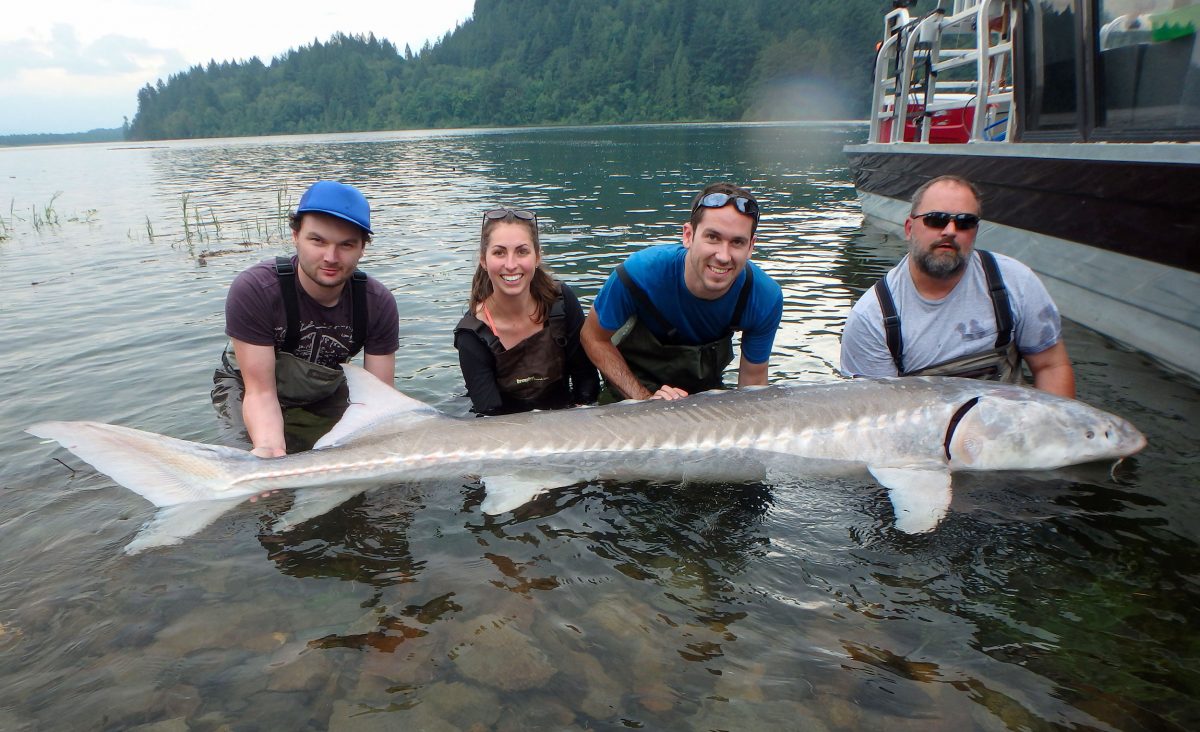
White sturgeon are the largest fish species found in freshwater ecosystems in North America. The largest sturgeon caught in the Fraser River in recent years was over 3.5 meters long. Photo courtesy of Erin Stoddard
The operation complete, 22497 was ready to go back in the water. Stoddard hoisted her out of the sling and lowered her into the estuary. She was disoriented at first, barely swimming. He leaned over the boat further, holding onto her as he pushed her deeper into the water. Now she could feel less of his hand, he explained, and more of the cold water running along her gills. A second later, her movements sharpened, as if she had woken up. Stoddard directed her into the current, and 22497 made a powerful snap of her fin. She vanished beneath the turbid water.
But Stoddard hadn’t lost track of her. He lowered an underwater microphone over the side of the boat, the same microphone I had dragged on the floor at the start of the trip. Someone flicked on a set of speakers linked to the acoustic transmitters, and a crackling white noise floated over the boat. Our group sat in the rain for a moment, listening to the static crackle of the water coursing under the boat. It felt like an art installation, the sound of actual water and recorded water mixing in the air around us. Then came a series of pings, cutting through the static, like the sound of someone clicking her tongue against the roof of her mouth: one ping after another after another. Six pings confirmed a single fish detection. A number flashed across the speaker’s screen: 22497 was alive and well and swimming along the bottom of the Fraser River. Now, she just needed to show Stoddard where she was going.
In the coming years, Stoddard’s study would continue to unlock new information about the fish. Some of the tagged sturgeon would indeed leave for the ocean, just as Stoddard hoped, and he would watch in fascination as they made pointed migrations in and out of salt water at specific times of the year. “Like clockwork,” he said. One spring he would catch a mature male he suspected was about to spawn at a site nearby. Later that year, he tracked that same male to the site and confirmed that, yes, that male was present during the spawn. Another revelation: white sturgeon in the Fraser River are not loyal to just one overwintering site, as biologists have observed in other populations. Perhaps those other sturgeon populations stick to one site because they’re swimming in more developed and dammed waterways than the lower Fraser River. In short, these other populations might have adapted to fit the modern world.
And, not too long ago, Stoddard confirmed a new feature of white sturgeon behavior that might directly help it survive. He pinpointed the start of spawning as the third week of May until the middle of July. The angling industry agreed to halt fishing trips during that time. Here was a real-world compromise that would help sturgeon recover and preserve the fishing population for angling companies, a win that Stoddard could point to whenever he had to justify the time and expense of his work.
Of course, the story of the white sturgeon is still unfolding. Each piece of new information unlocks more questions. “That’s a standard theme with sturgeon biologists,” Stoddard said. “The more you learn, the more you don’t know.” That’s also a standard theme when it comes to studying the ocean. We uncover new species of deep-sea octopuses or a chain of underwater mountains, and again we realize that we simply don’t know enough about the world’s largest ecosystem.
From The Imperiled Ocean by Laura Trethewey, published by Pegasus Books. Copyright © 2019 by Laura Trethewey.

